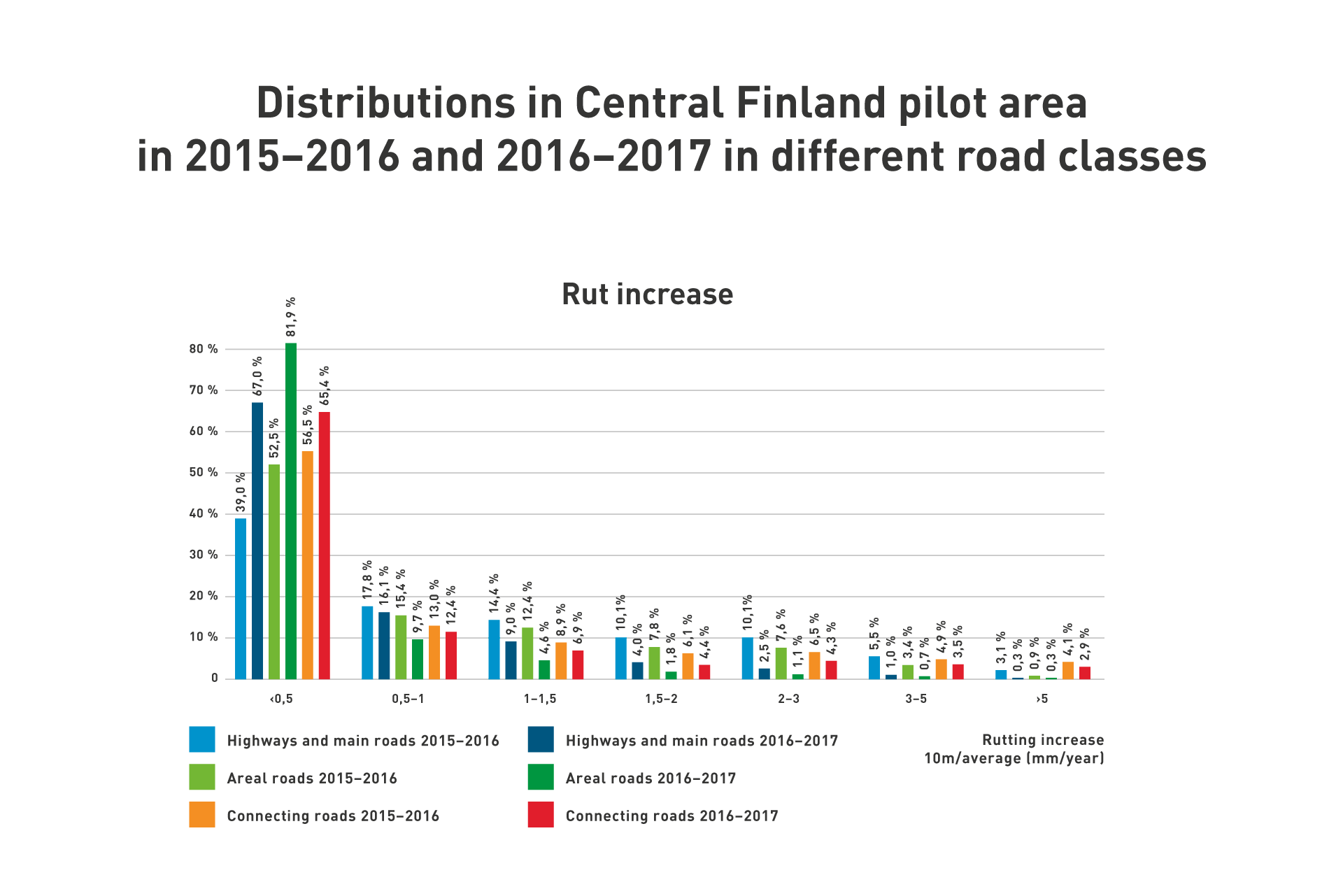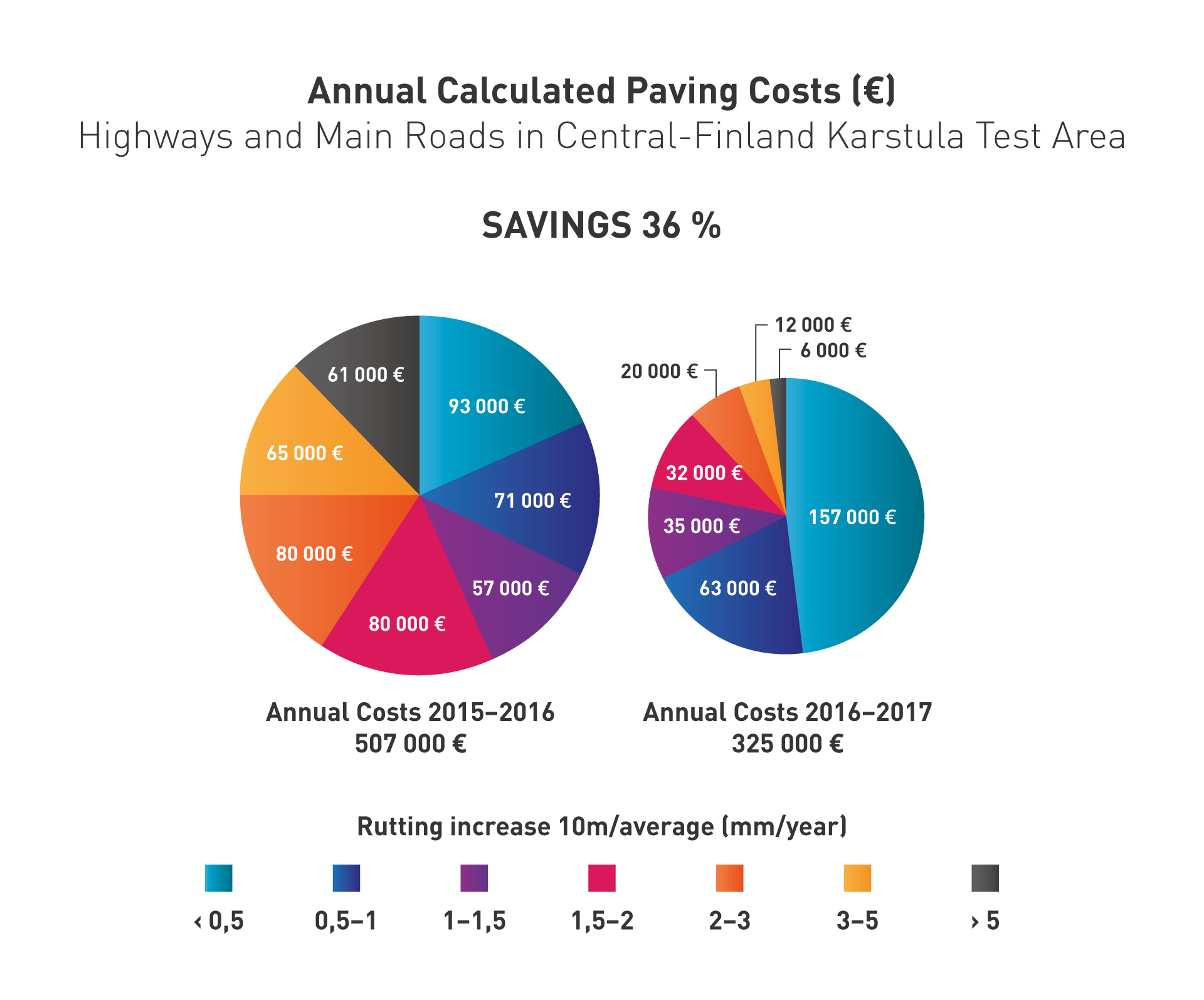
The PEHKO project is largely based on long term work, carried out by ROADEX projects and ROADEX Network within the Northern European Road Agencies and on Roadscanners’ own product development.
The PEHKO project has now been underway since 2015 and preliminary results have exceeded expectations. Right from the start the weakest links reducing pavement life and increasing cycle costs were identified. These sections, spread all over the network, covered only 10-20% of the length, but incurred up to 50% of the annual paving costs due to deficiencies in both pavement structures and daily maintenance. Typical structural problems were thin pavements and heavy trucks on road sections with soft subgrade soils. Maintenance deficiencies were mainly associated with poor drainage and inadequate winter maintenance.

PEHKO pilots in Lapland and Central-Finland areas started in 2015 and in 2018 Uusimaa region joined in.
The project in Lapland covers altogether 1252 km of paved roads in the Kemi-Tornio area and main roads of the Rovaniemi area.
In Central Finland, the project covers paved roads in the Karstula area with a total length of 401 km.
The Uusimaa area PEHKO roads are located in the Hyvinkää maintenance area and their total length is 860 km.

PEHKO project
The basic idea and goal for the PEHKO project is to improve practices and policies in paved road maintenance and management and thereby improve the condition of the paved road network, or at least keep it at the current level using less resources. This is being done by focusing on three targets:
1. Improving daily maintenance, especially drainage.
2. Applying new NDT methods in the diagnostics of paved roads. These techniques allow engineers to focus rehabilitation measures exactly on the problem sections and address the root of a problem.
3. Changing maintenance policies from reactive to more proactive maintenance, allowing maintenance crews to fix the potential problem sections before serious pavement damages appear.
Valuable information
PEHKO project will also produce valuable information about the life cycle costs of paved roads and about the factors that have the greatest impact on them. In other words, the goal is to detect the “weakest links” that affect the annual paving costs of the road network and to find new solutions to fix these problems – and increase the productivity of paved road maintenance practices. If this can be realized at least in parts of the PEHKO project roads, the annual pavement maintenance costs caused by pavement fatigue will drop in 10 years, at best, by more than 50% compared to current costs. In practice this means future savings of over 50 – 100 million Euro in annual pavement maintenance costs of the paved road network in Finland.
Figure showing rutting increase distribution from years 2015-2016 and 2016-2017.
During the first years of the project, the most critical issues that have emerged concerning paved roads are:
- Deficiencies in drainage – private access roads without culverts. Big problem, but easy to repair.
- Deficiencies in drainage – side ditches and outlet ditches. These cause, for example, frost and deformation problems.
- Deficiencies in winter maintenance – snow removal from road shoulder is done too late. This cause edge deformation and traffic safety problems. This is an increasing problem due to climate change.
- New heavy trucks with super single tyres and increasing total weights are accelerating permanent deformation related rutting on roads with thin pavements.
- Heavy trucks on weak subgrade. This is major problem especially on roads resting on peat. The best solution for these problems is to use steel reinforcement
- Issues with pavement quality has also been found to be a key reason behind the problems in certain areas
- There is also evidence that thin pavement and heavy use of deicing salt are a combination that leads to rapid rutting.
Figure showing calculated annual paving costs in Karstula PEHKO area in 2015-2016 and 2016-2017.
The first calculations concerning the impact of the new, improved and focused methods on annual paving costs were made in 2017. In Central Finland, where there was slightly more funding, the calculated annual costs fell by as much as 30%. The same figure in Lapland was 12%. The results also showed that the impact of daily maintenance on the pavement backlog could be up to 50%. With these encouraging results it is expected that the target of 50% reduction in calculated annual paving costs can be reached by 2025.
Table showing development of calculated annual costs and cost savings in Lapland and Central-Finland areas in different road classes.
Benefits
- Better understanding of root causes of road damage
- Better daily maintenance management
(drainage, winter maintenance) - Better pavement design practices
- Heavier measures focused on exact problem locations
- Optimized pavement thickness
- New structural solutions for roads over weak subgrades
- Enables monitoring of performance of new structures
(learning process)
- Safer and better winter roads
- Enabling proactive pavement maintenance policies
- Repaving before pavement loses its strength
- Longer pavement lifetimes
→ Major savings
More information about Roadscanners road assett management
services and products you are able to see from here:
Road Asset Management
 Improving Productivity of Paved Road Asset Management
Improving Productivity of Paved Road Asset Management


